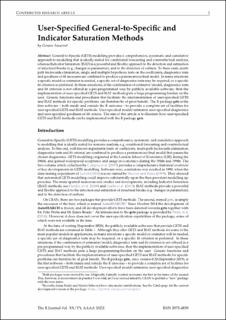| dc.description.abstract | Abstract General-to-Specific (GETS) modelling provides a comprehensive, systematic and cumulative approach to modelling that is ideally suited for conditional forecasting and counterfactual analysis, whereas Indicator Saturation (ISAT) is a powerful and flexible approach to the detection and estimation of structural breaks (e.g. changes in parameters), and to the detection of outliers. To these ends, multi path backwards elimination, single and multiple hypothesis tests on the coefficients, diagnostics tests and goodness-of-fit measures are combined to produce a parsimonious final model. In many situations a specific model or estimator is needed, a specific set of diagnostics tests may be required, or a specific fit criterion is preferred. In these situations, if the combination of estimator/model, diagnostics tests and fit criterion is not offered in a pre-programmed way by publicly available software, then the implementation of user-specified GETS and ISAT methods puts a large programming-burden on the user. Generic functions and procedures that facilitate the implementation of user-specified GETS and ISAT methods for specific problems can therefore be of great benefit. The R package gets is the first software – both inside and outside the R universe – to provide a complete set of facilities for user-specified GETS and ISAT methods: User-specified model/estimator, user-specified diagnostics and user-specified goodness-of-fit criteria. The aim of this article is to illustrate how user-specified GETS and ISAT methods can be implemented with the R package gets. | en_US |

